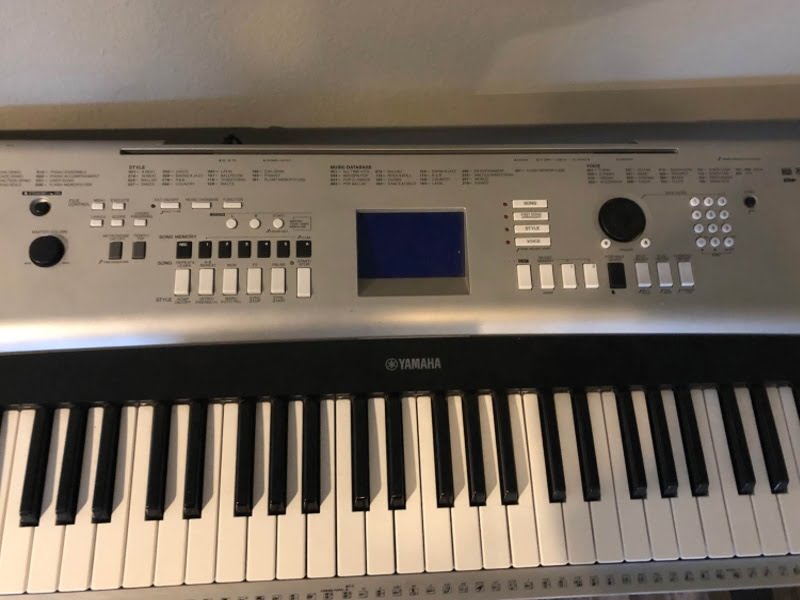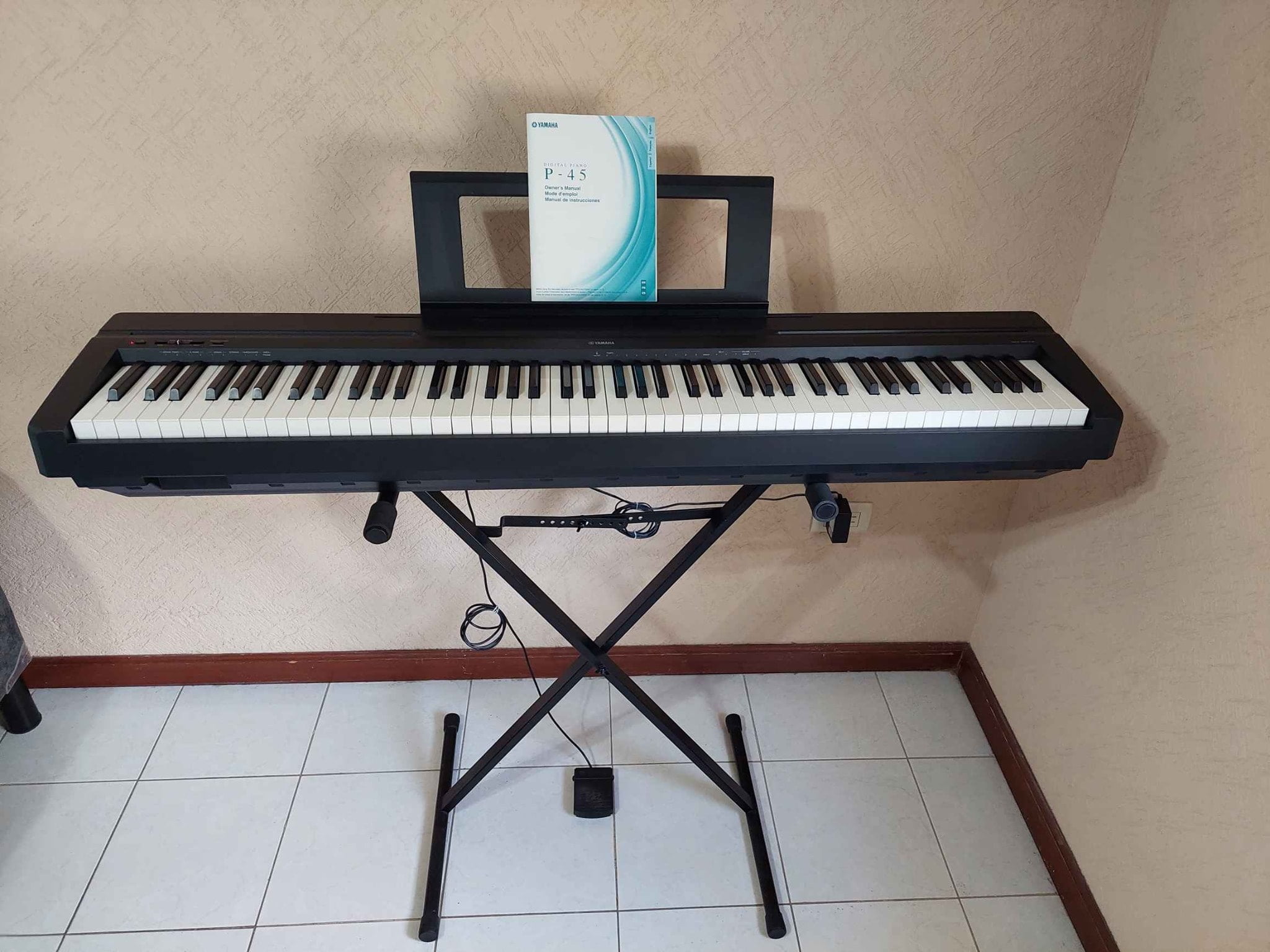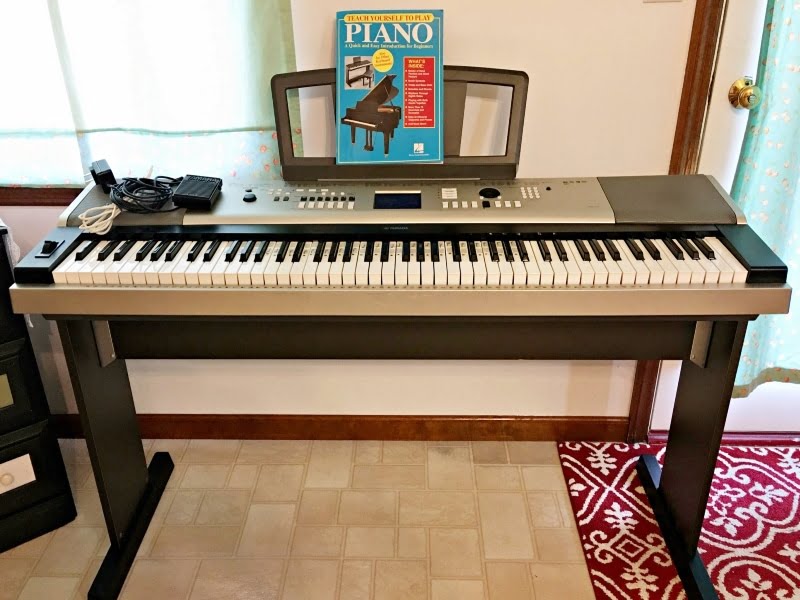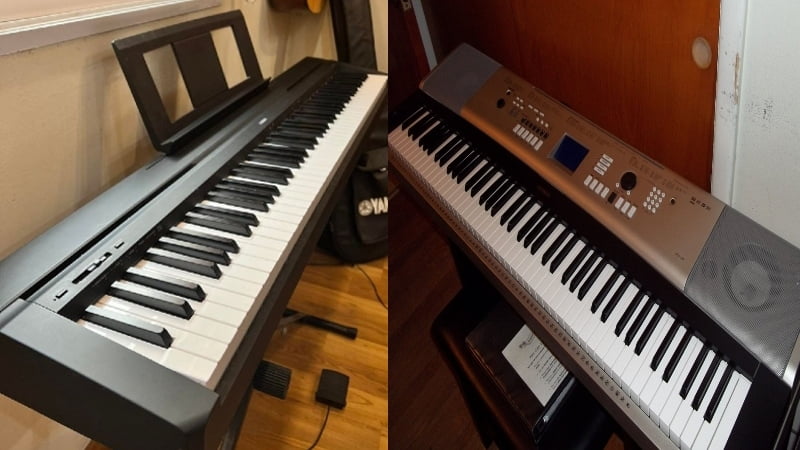Yamaha is known for making great digital pianos at a fair price. Learn which affordable Yamaha digital piano is a better pick in this Yamaha P45 vs YPG 535 comparison.
When looking for an affordable digital piano that feels and sounds good, most people point to Yamaha. And two models that are usually brought up in the same breath are the P45 and the YPG535.
They are both in the same price range, but they are made for different types of pianists. And in this Yamaha P45 vs YPG-535 comparison, you’ll learn which option best fits your needs.
After rigorous testing, I found that the Yamaha P45 better suited my needs. This piano felt more like a real piano, had higher-quality voices, and came with a decent set of piano features. The P45 is a great option for people who want an instrument replicating an acoustic piano.
On the flip side, the YPG-535 is best for performing pianists that need versatility. It has more voices and features, but it doesn’t feel as close to an acoustic piano as the P45.
Since these two pianos are designed for different people, comparing the two was a whole lot of fun. Keep reading to learn how the Yamaha P45 edged out the YPG-535 in a head to head comparison.
Yamaha P45 vs YPG 535: Comparison Chart




Last update on 2025-04-13 / Affiliate links / Images from Amazon Product Advertising API
Yamaha P45 vs YPG 535: The Features
The Yamaha P45 and YPG 535 are very different from each other. So, comparing the two by putting their features up against each other was really easy. And by the end of it all, the Yamaha P45 narrowly edged out a win with a score of 3-2.
While I preferred the Yamaha P45, I have to admit that there are some pianists that would benefit more from the YPG 535. The right option for you will largely depend on the type of music you play on your personal preferences.
So, let’s dive deeper into the features of both pianos so you can determine which one is the best fit for your needs.
Tone
The winner: Tie
Both of these pianos produce very high-quality tones. And while I preferred the tones coming from the P45, the YPG-535 offers a much wider variety. So, if you’re looking for quality over quantity, the P45 takes the point. But if you need more versatility and want to experiment with different sounds, the YPG-535 will be the best pick.
+Sound Library
Let’s start with the sound library. The Yamaha YPG-535 has an impressive sound library with over 500 different voices to choose from. This includes a couple of tones that use the AWM stereo sampling generator and other tones that come from the GXLite pack.
So, you won’t complain about variety and a lack of options when using the YPG-535. That said, I have to admit that some tones are of higher quality than others. While the Yamaha YPG-535 has a share of decent piano tones, I noticed that some of the other voices sounded very digital and synthetic.
But if you’re looking for variety, there’s no denying that the YPG-535 is an attractive option.
The P45 takes an entirely different approach to the sound library. Instead of packing the piano with various voices, the P45 only has ten options. This includes various piano tones, some synth tones, and a couple of strings and bass voices.
While these aren’t a lot, I can say that they are top-quality. When testing out the pianos, there was no denying that the sounds from the P45 were much richer and more realistic. And I’ll explain why in the next section.

+Tone Generation
On the surface level, it might seem like the two pianos generate tones similarly. This is because they both utilize the AWM sampling method. However, I quickly found out that they use the AWM Stereo Sampling tone generator in very different ways.
The P45 uses AWM sampling in all its voices. So, whether you’re using the synth, piano, or strings tones, you can rely on top-quality samples. This is the reason why I noticed the tones on the P45 were much richer and brighter compared to the YPG-535.
The YPG-535 only uses AWM Stereo Sampling for some of its voices, and the difference is crystal clear. So, expect that some of the voices on the YPG-535 won’t be top-quality as it uses the GLite sound pack instead of AWM Stereo Sampling.
Feel & Playability
The winner: Yamaha P45
Another feature I made sure to factor in when comparing these pianos was the feel and playability. I prefer pianos that emulate the feel of a real acoustic piano. And for that reason, the Yamaha P45 gets the point.
+Hammer Action
The Yamaha P45 comes with a great hammer action system that replicates the feel of an acoustic piano. The YPG-535, on the other hand, doesn’t have weighted keys, which might not be the most comfortable experience for most pianists.
The Yamaha P45 uses the Graded Hammer Standard or GHS of Yamaha. This is a signature of many Yamaha pianos as it replicates the subtle weight differences on a real acoustic piano. So, you will notice that the lower keys on this piano are significantly heavier than the lighter keys.
The Yamaha YPG-535 doesn’t have that. In fact, this piano doesn’t have weighted keys at all. And while some pianists won’t be able to play without the weighted keys, there may be some people out there who prefer the feel of the YPG-535.
That said, one thing this piano does have is a graded soft touch. This means the piano reacts to how hard or soft you press the keys. So, if you press the keys harder, it gets louder, and plays a softer note if you press it gently.
+Key Texture
When it comes to feeling, these two pianos are tied in terms of key texture. Both pianos have glossy plastic keys, which do not emulate the feel of wooden piano keys at all. In fact, when I played both pianos, I noticed that the keys felt fairly slippery, which was far from ideal.
It would have been nice to see wooden keys or at least a textured coating on the keys to making it more comfortable. Granted, this isn’t a big deal for beginners. But if you’re used to playing wooden keys on an acoustic piano, the texture might feel off at first.
Piano Features
The winner: Tie
The last comparison point I had for these two models was the piano features. This includes playing modes, effects, and polyphony. And in the end, I couldn’t pick a winner and gave the point to both pianos. The P45 and the YPG-535 have different piano features designed for different types of pianists, so it was pretty hard to pick a winner in this category.
+Playing Modes

The first thing I compared was the different playing modes. And to my surprise, the YPG-535 actually came with more playing modes. This piano has split, dual, and lesson modes which are all very useful.
With split mode, you can load two voices at the same time. You can assign one voice to the bass keys and one voice to the higher keys so you can fill in more sonic space in the music. Dual mode is similar, but instead of dividing the piano, it blends the two voices together to create a unique sound.
The lesson mode on this piano is quite different from other lesson modes. For example, the lesson mode available on the P45 divides the piano into two smaller pianos. That way, a teacher and student can play the piano at the same time and play the same notes.
On the YPG-535, the lesson mode consists of actual lessons. There’s a repeat and learn, waiting, minus one, and chord dictionary features on this piano, which is great for beginners. That said, they aren’t as good as actual piano lessons.
As mentioned earlier, the P45 has a more traditional type of lesson mode. On top of that, it has dual modes. However, the piano is noticeably lacking split mode, which would have been a great feature to have on the P45.
+Effects
The P45 only comes with one effect, but it’s one of the most useful effects for a pianist to have: reverb. With this effect, you can add tons of depth and body to your existing tone, which is why it’s a favorite for many pianists. While it would have been nice to see other effects, it’s great that the one effect the P45 has is also one of the most useful available.
The YPG-535 also has reverb effects, including chorus and EQ. The chorus effect is a great addition to many of the voices on the piano. And while the EQ effect may be a bit tough for beginners to use, it’s a great way to take full control of your tone.
+Polyphony
My biggest complaint with the YPG-535 is the polyphony. This piano only has 32-note maximum polyphony. This means you can only play 32 notes simultaneously and expect clarity. And while this is more than enough for regular piano pieces, it might get in the way if you play many notes and chords while using the dual or layering modes.
The P45 has 64-note maximum polyphony. This is great as it can handle twice as many samples as the YPG-535. This gives the P45 much more flexibility and is one of the main reasons I ended up choosing it over the YPG-535.

Yamaha P45 vs YPG 535: The Similarities
You can probably already tell that these are very different pianos. They have their own sound library, feature set, and even hammer action systems that made this comparison a lot of fun. That said, they do also share some similarities worth noting.
For example, they use AWM stereo sampling for many of their voices. This is why the voices on the P45 are top-quality as well as some of the sounds on the YPG-535. Additionally, the pianos are very portable and easy to bring around. That way, you won’t have a hard time packing up the piano and bringing it to rehearsals, performances, and even piano lessons.
If you’re looking for a more traditional piano, there’s no doubt that the P45 is the better option. It has great tones, a realistic hammer action system, and a true digital piano. The YPG-535, on the other hand, is more fo a digital keyboard.
So, while you won’t get the realism of the P45, you do get more flexibility and variety when it comes to your sounds.
Quick Rundown of the Yamaha P45
- Includes the P45 Digital Piano, power adapter, sustain pedal and music rest
- 88 fully weighted piano style keys simulate the feel of an acoustic piano and provide a quality playing experience
- GHS weighted action is heavier in the low end and lighter in the high end, just like an acoustic piano
- Contains 10 different voices, including digitally sampled tones from real Yamaha acoustic grand pianos
- Dual mode lets you combine 2 voices together, like piano and strings, for an inspiring new playing experience. Tuning- 414.8 - 440.0 - 446.8 Hz
Last update on 2025-04-13 / Affiliate links / Images from Amazon Product Advertising API
Quick Rundown of the Yamaha YPG 535
- Your purchase includes One Yamaha Portable Grand Piano, YPG535 model | Music Rest, Power Supply (PA-150), Sustain Pedal (FC5), Owner’s Manual and CD-ROM
- Piano dimensions (with stand) – 53-1/3” W x 30-1/2” H x 19-1/8” | Weight (with stand) – 37 lbs. | Display Size – 320 x 240 dots
- Specifications: Headphones – 1 | Sustain Pedal – 1 | USB to device | USB to host | Reverb – 9 types | Chorus – 4 types | Master EQ – 5 types
- Yamaha Portable Grand comes with 30 built-in songs plus 70 more on an included CD-ROM and an interactive lesson system, divided into left and right hand parts, for learning them
- Keyboard is not weighted. Easy-to-use panel, a wealth of piano-centric features including piano-style keys, Graded Soft Touch (GST) action with different levels of resistance and a high-resolution stereo piano sample
Last update on 2025-04-13 / Affiliate links / Images from Amazon Product Advertising API
Product Videos
References:
- Yamaha P45: https://usa.yamaha.com/products/musical_instruments/pianos/p_series/p-45/specs.html#product-tabs
- Yamaha YPG 535: https://usa.yamaha.com/products/musical_instruments/pianos/p_series/ypg-535/specs.html
Lulacruza is an electronic folk duo operating at the junction of the hypermodern and the ancient. Our music weaves together hypnotic female singing, South American folk instruments and electronic processing, while channeling pulsating waves from the source of creation.
Lalucruza is also a community where you can connect with other music lovers to collaborate, exchange ideas and share knowledge. A platform for who wants to learns the basics of playing piano, guitar, drum masters’ technique, etc.. is the premise of our website.
